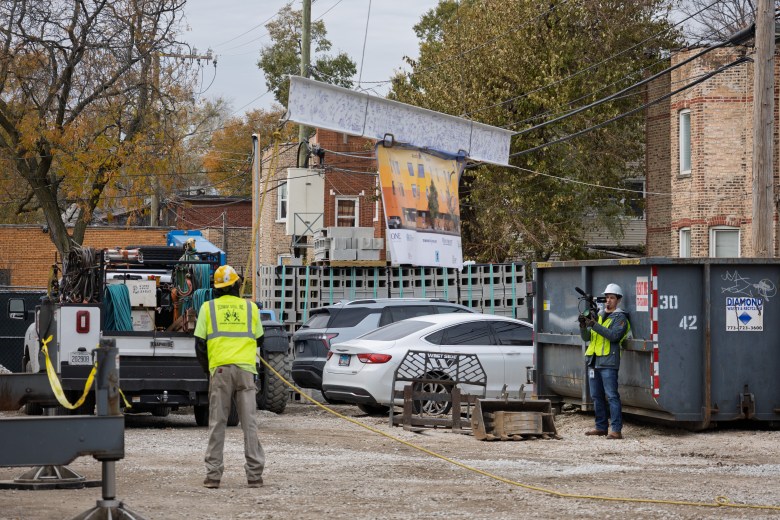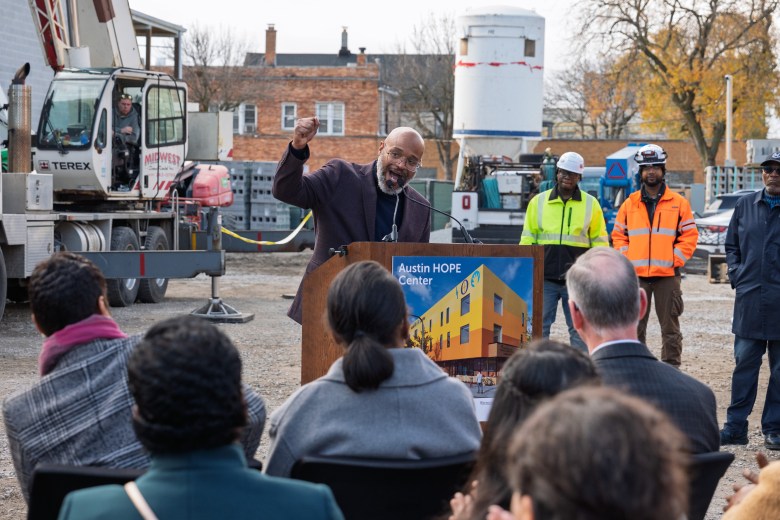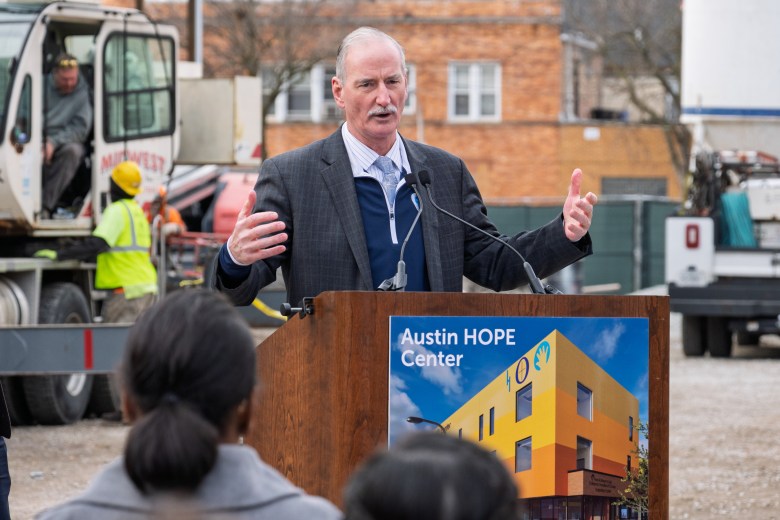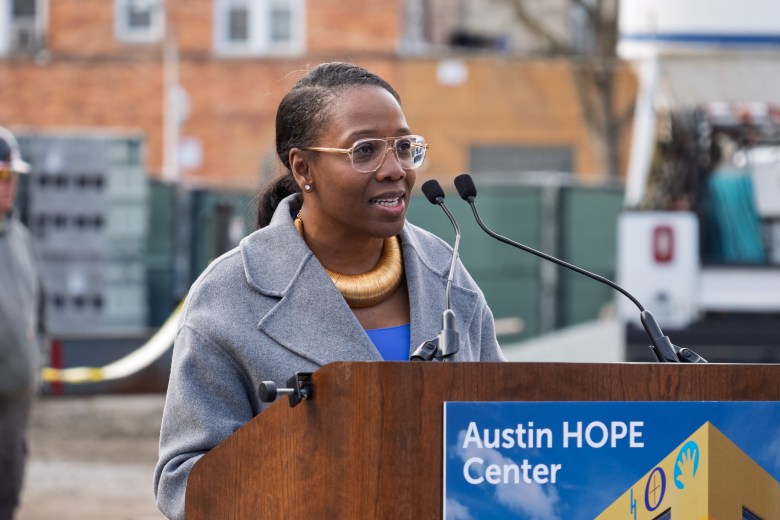A crane lifted the final beam of the Austin HOPE Center onto the frame of the building on Nov. 17, completing the internal structure of the West Side’s first standalone pediatric specialty and behavioral health facility.
The 25,000-square-foot building at 5036 W. Chicago Ave is expected to be completed in late summer next year, when Lurie Children’s Hospital will provide youth in and around Austin with affordable, high-quality primary care, behavioral health resources, and services for children with chronic diseases.
 The final beam is lifted by crane | Todd Bannor
The final beam is lifted by crane | Todd Bannor
 Constuction workers guide the final beam into place | Todd Bannor
Constuction workers guide the final beam into place | Todd Bannor
“Let this beam be a banner of hope, a symbol of unity and a reminder that, when community comes together, transformation follows,” said Pastor Contrell Jenkins, CEO of Stone Community Development Corporation and pastor at Lively Stone Missionary Baptist Church, at the beam raising ceremony. Jenkins brought the idea for the HOPE Center to Lurie Children’s Hospital, according to its CEO Tom Shanley.
“Children today are only 20% of the entire Medicaid spend, but they’re 100% of our future,” Shanley said at the ceremony. “We have to get to the point where the zip code is not the most important determinant of your health and well-being. This project is going to make sure that, if you live in Austin, you are going to come out with the same exact health care that you have anywhere in the city.”
 Pastor Contrell Jenkins of Stone CDC and Lively Stone MB Church speaks at the topping off ceremony for the new Austin HOPE Center | Todd Bannor
Pastor Contrell Jenkins of Stone CDC and Lively Stone MB Church speaks at the topping off ceremony for the new Austin HOPE Center | Todd Bannor
 President and CEO of Lurie Children’s Hospital Tom Shanley, MD, speaks at the topping off ceremony on Nov. 17, 2025 | Todd Bannor
President and CEO of Lurie Children’s Hospital Tom Shanley, MD, speaks at the topping off ceremony on Nov. 17, 2025 | Todd Bannor
The first floor of the Austin HOPE Center will house offices and programming space for Stone CDC, plus a cafe and community meeting spaces. Lurie’s Children Hospital will be based on the second floor, offering clinical exams and services for specialty care, behavioral and physical health. Offices for Thresholds, which provides services for mental health and substance use, will be on the third floor.
Shanley said that local youth have had an integral role in designing and developing the HOPE Center — the thing he’s most proud of in building the center.
At the beam raising, Ahking Garrett, a student from Christ the King Jesuit College Prep in Austin, shared what being involved in the project meant to him.
“I can stay involved in this project by using my voice as a Black boy and a Black teenager from the West Side of Chicago to bring things that people like me want to see in the world,” Garrett said. He’s a part of the school’s United Nations club, where he and over a dozen other students brainstormed the center’s scope of operations and its name (which was previously the Austin Community Health Hub).
 Christ the King student Ahking Garrett | Todd Bannor
Christ the King student Ahking Garrett | Todd Bannor
Darnell Shields, the executive director of Austin Coming Together, told Austin Weekly News that he wants to see more young people involved with community projects like the HOPE Center.
“Can you imagine the impact this is going to have on them growing up?” Shields said, to be a part of a multi-million-dollar project. As a child who’s involved, “I’m not thinking that that’s not possible. I’ve seen it happen.” He added, “This is evidence and proof that you are worthy, cared for and that you do matter because look at the investment that is happening in support of you.”
Austin Coming Together helped to convene the groups involved with the HOPE Center and advocate for its funding and resources. The HOPE Center is also a part of ACT’s Austin Forward. Together quality-of-life plan that aims to improve the neighborhood’s community narrative, youth empowerment and economic development among other goals.
 Chicago Deputy Mayor Kenya Merritt speaks at the topping off ceremony for the new Austin HOPE Center on Nov. 17, 2025 | Todd Bannor
Chicago Deputy Mayor Kenya Merritt speaks at the topping off ceremony for the new Austin HOPE Center on Nov. 17, 2025 | Todd Bannor State Representative La Shawn Ford signs the final beam at the topping off ceremony | Todd Bannor
State Representative La Shawn Ford signs the final beam at the topping off ceremony | Todd Bannor Attendees sign the final beam | Todd Bannor
Attendees sign the final beam | Todd Bannor
Other groups involved in the development of the HOPE Center include Thresholds, the Chicago Neighborhood Initiatives and Wintrust Bank. UJAMAA Construction is building the center, and Gregory Ramon Design Studio designed it.
The building has been funded by new market tax credits from the Chicago Development Fund, plus grants from the Chicago Department of Planning and Development, the Illinois Department of Commerce and Economic Opportunity, the U.S. Department of Health and Human Services and Lurie Children’s Hospital.
 Chicago Department of Planning and Development Commissioner Ciere Boatright speaks at the topping off ceremony for the new Austin HOPE Center | Todd Bannor
Chicago Department of Planning and Development Commissioner Ciere Boatright speaks at the topping off ceremony for the new Austin HOPE Center | Todd Bannor
It’s among the first brick-and-mortar projects in Chicago to use proceeds, $5 million worth, from the Chicago Housing and Economic Development bond, according to Ciere Boatright, commissioner of the Chicago Department of Planning and Development.
But the $22 million project, which broke ground last June, still needs $4.8 million of funding. At the beam raising ceremony, State Rep. La Shawn Ford called for additional financial assistance for the HOPE Center.
“As a state legislator, I feel like we have to do everything that we can to help the Stone Community Development Corporation pay this off because we know that state reimbursement rates are low, and we know that government funding is not what’s going to do it,” Ford said. “This is going to be great, not just for the West Side of Chicago, but for the health of our city.”
 State Representative La Shawn Ford speaks at the topping off ceremony Nov. 17, 2025 | Todd Bannor
State Representative La Shawn Ford speaks at the topping off ceremony Nov. 17, 2025 | Todd Bannor
 Chicago Deputy Mayor Kenya Merritt at the topping off ceremony | Todd Bannor
Chicago Deputy Mayor Kenya Merritt at the topping off ceremony | Todd Bannor
Kenya Merritt, Chicago’s deputy mayor of business, economic, and neighborhood development, said a resource like the HOPE Center is long overdue in Austin, which has seen decades of systemic disinvestment that impacts residents’ health and life expectancy.
“For far too long, the people of Austin and the West Side have been asked to settle for less,” said Merritt, an Austin resident. “We’ve had to travel too far, wait too long and beg for the same quality-of-life care that other parts of the city take for granted. So, when we look at this structure, I don’t see concrete and steel. I see a physical manifestation of our city’s renewed commitment to equity.”
“We aren’t just celebrating a new building,” Merritt added. “We are celebrating a promise kept to the people of the West Side.”
Related

